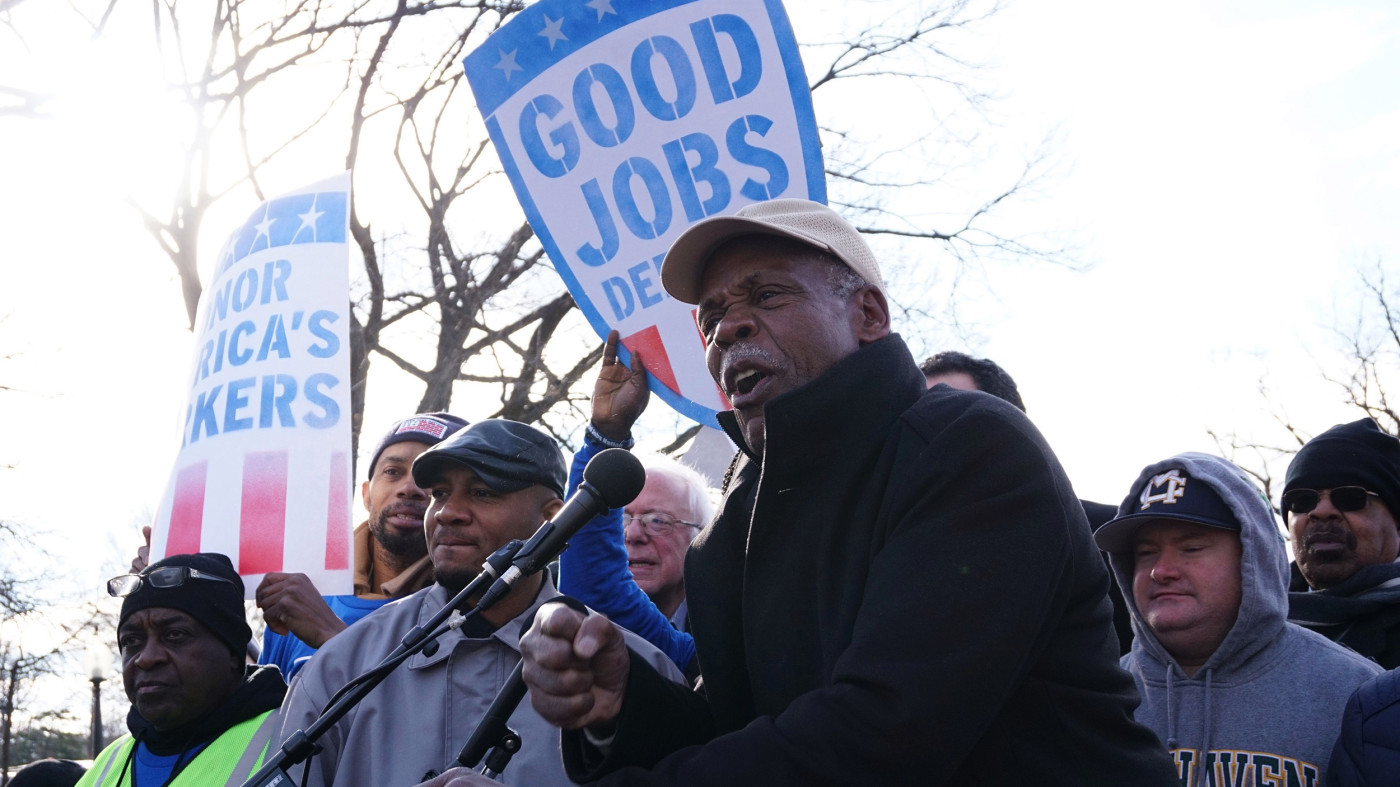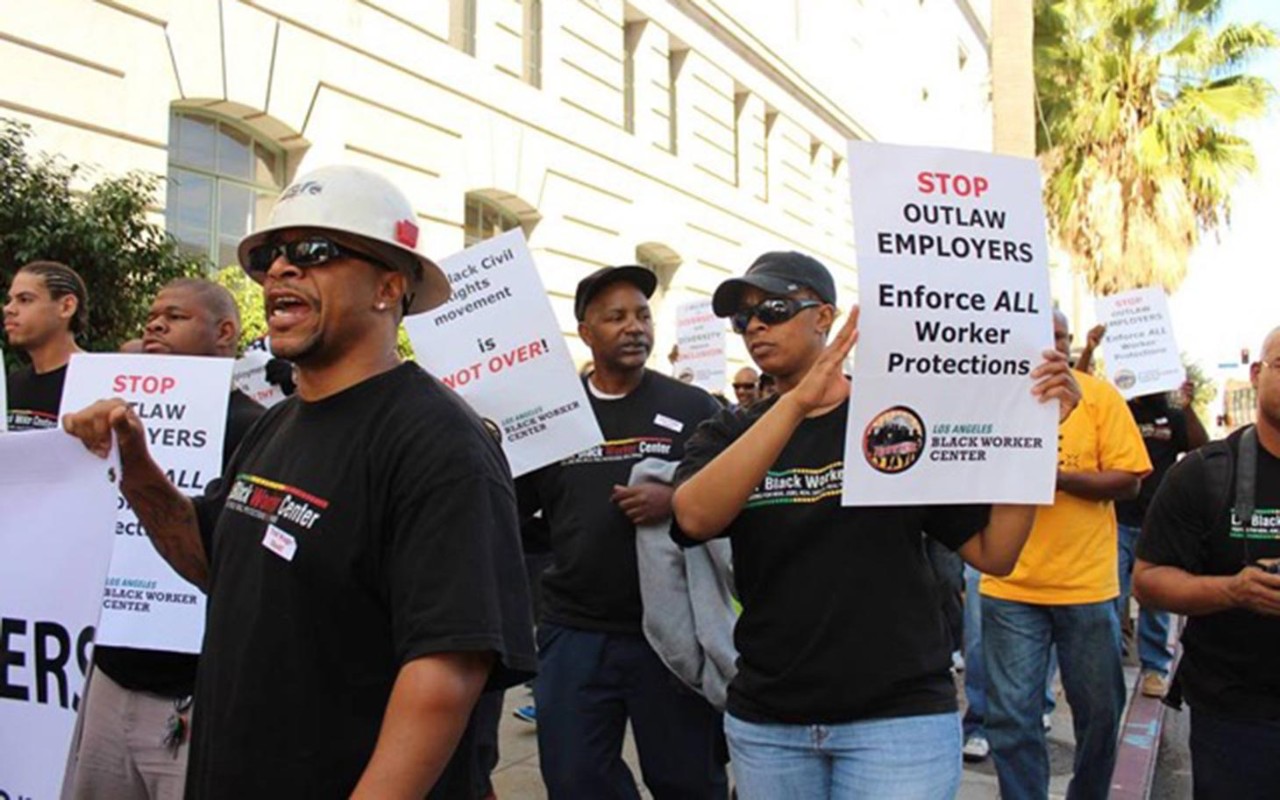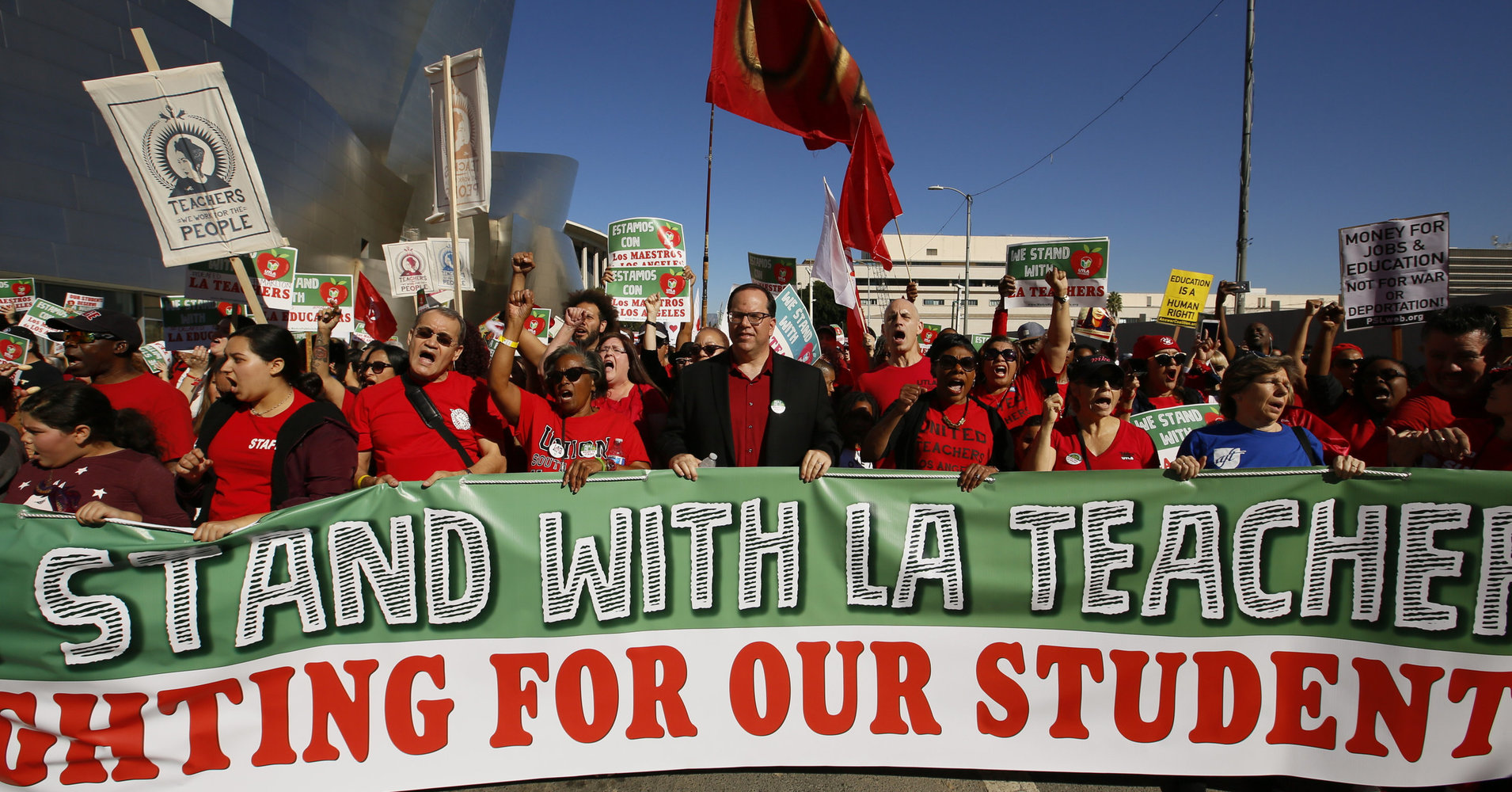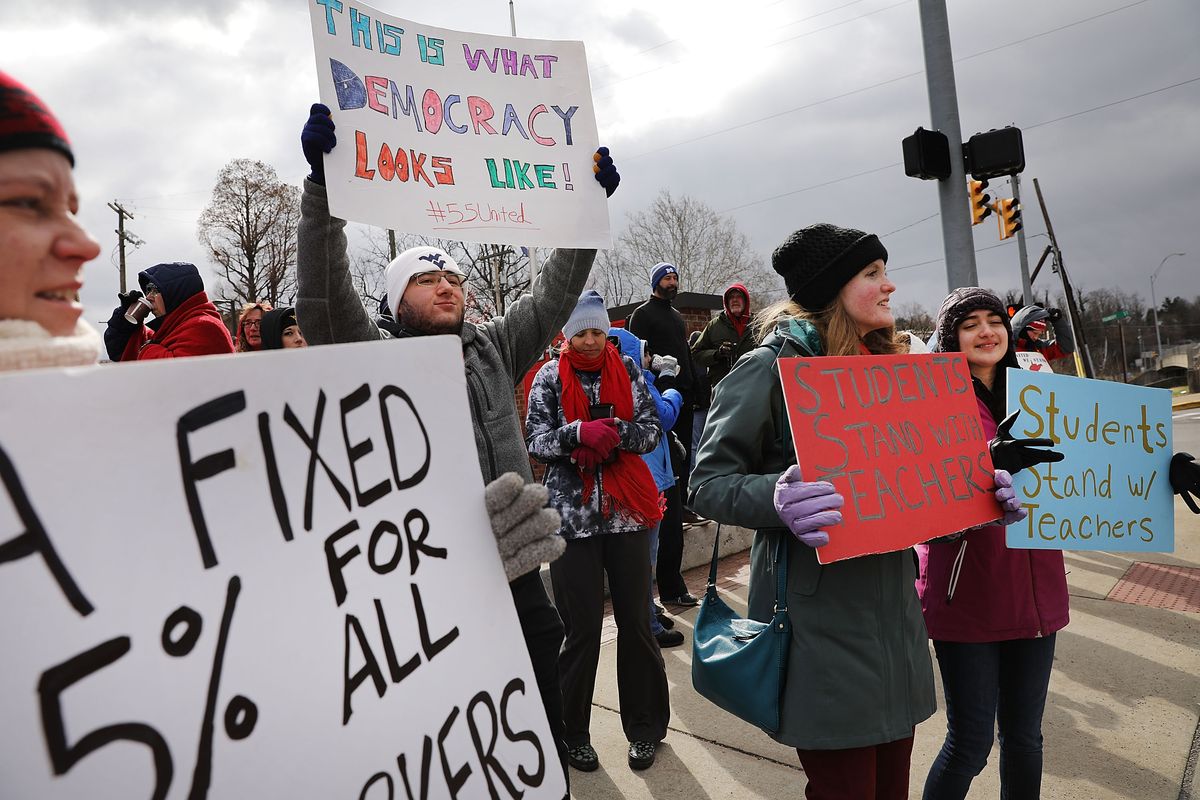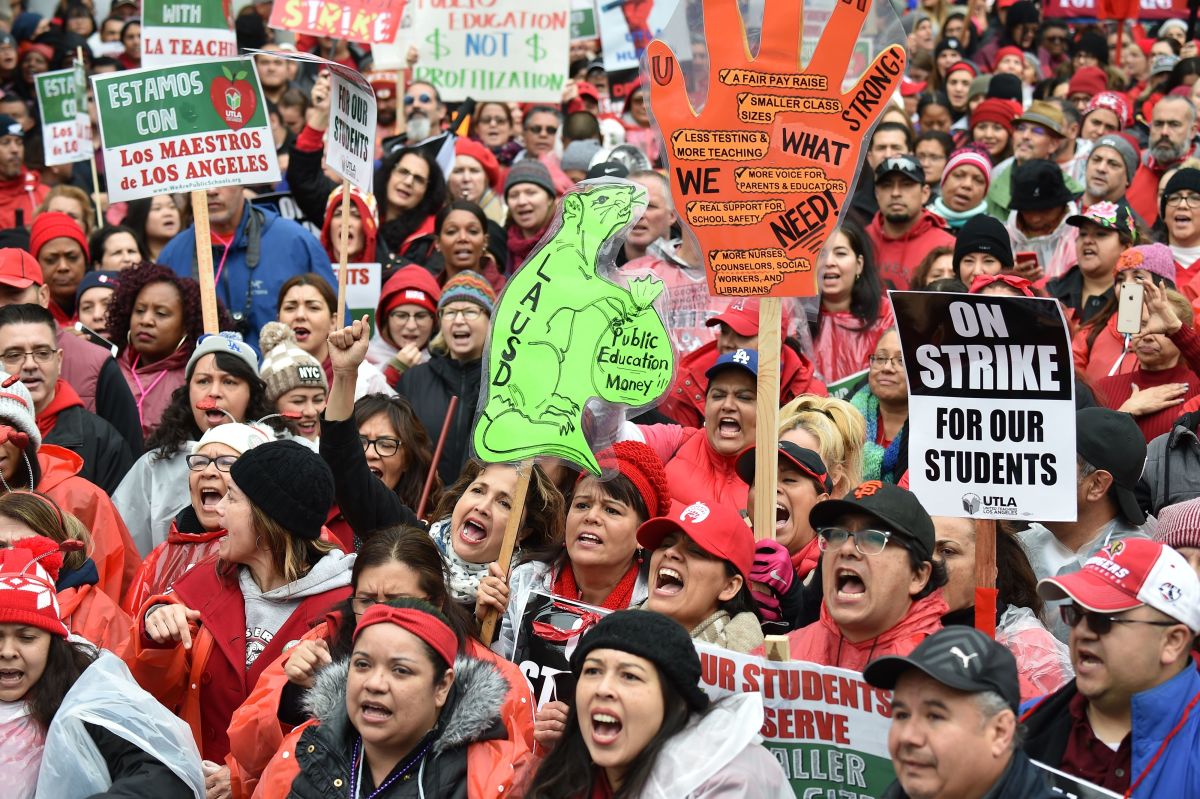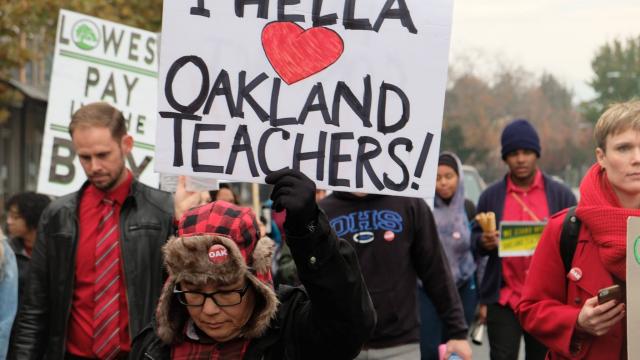
National Labor Relations Board data indicate that 2018 marked a huge upsurge in strikes by workers across the U.S. The year saw 21 major work stoppages involving 485,000 workers, compared with 25,000 in 2017. The most obvious takeaway is this: In the year of the Janus Supreme Court decision that prevented unions from charging fees to non-union workers who still benefit from union-negotiated contracts, workers were anything but cowed.
Teachers in several so-called red states, starting with West Virginia, organized and walked out of their schools, winning significant victories and asserting that they were fed up with the underfunding of education, going back years, all while states were cutting taxes and giving fossil fuel corporations more and more concessions.
Other workers struck across the country, including hotel workers, university graduate students, United Steelworkers locals, and staff of the University of California Medical Centers up and down the state.
A confluence of events
The year 2019 started with federal workers under assault because of the prolonged government shutdown. Most stayed home, although those deemed critical for work operations were forced to come in. All were unpaid as were hundreds of thousands of government contractors.
Finally, after several weeks of this agony, air traffic controllers and TSA workers in New York called in sick, disrupting air traffic across the Eastern Seaboard. On the same day, the flight attendants union threatened to strike, declaring that industry safety was being compromised. Along with simmering protests elsewhere, these two actions forced the Trump administration and its allies in Congress to relent and re-open the government.
In the midst of the government shutdown crisis, Los Angeles teachers hit the streets, winning a major victory for education funding, more resources in schools, and teacher pay. And in just the past month, teachers in Oakland, Calif., walked out for a week while North Carolina, Kentucky, West Virginia (again) and Denver saw various levels of teacher activism from one-day walk-outs to sick-outs to strike authorization votes. Many of these situations remain unresolved.
Then, in late February, employees at a locomotive manufacturing plant in Erie, Pa., walked out when the factory’s new owners refused to honor key elements of their previous contract with GE Transportation. After nine days, workers and management reached an agreement for a 90-day cooling off period to allow for negotiations on a new contract.
At nearly the same time, workers at Stop and Shop, New England’s largest grocery store chain, voted overwhelmingly to authorize a strike if management follows through on its declared intention to reduce workers compensation during ongoing contract negotiations.
Implications of growing labor movement
What does all of this labor activism mean and how could it develop in coming months and years? Steven Greenhouse in the American Prospect suggests that, while the increased activism and wins have been inspiring, it is still not clear that labor can maintain the momentum against stiff opposition from corporations and the federal government.
From a narrow labor and worker perspective, skepticism is definitely warranted. The decline of manufacturing and the political balance of power in the country mean that worker organizing will continue to be difficult.
But worker actions must also be seen in the context of, and as a response to, a decades-long attempt to privatize the economy and impose austerity on spending for public goods like education, transportation, healthcare, etc. These cuts have only been exacerbated by the continuing fallout from the 2008 financial crisis that imposed huge suffering on the bottom half of the population, which still has not recovered.
Occupy Wall Street may have been the first major response to austerity and the financial crisis, making the point that while the 1 percent was doing just fine – and actually grabbed more wealth after the 2008 financial meltdown – the rest of the economy was still in recession. There are conflicting views about how successful Occupy was, but it significantly shifted the public conversation to economic justice for ordinary people.
The labor actions of the past few years are another thread of the resistance to the neoliberal economic and social order. Occupy was followed by major protests against Governor Scott Walker in Wisconsin, the Chicago teachers strike in 2012, and other labor actions including the Fight for $15 movement and the mobilization of the Seatac airport workers.
It is also critical to remember that neoliberalism has never been passive. It didn’t just constitute a stable, if unbalanced, economy that tended to benefit those on top. Its right-wing adherents in government and the private sector have actively sought to entrench and increase the inequalities in the economy and the politics that supported it.
Supreme Court decisions on Citizens United and the Voting Rights Act as well as the Janus decision must be seen in this light. The suppression of African American voters by Republican governors and legislatures, along with the influx of huge sums of dark money into U.S. electoral politics, were major blows against minorities, working people and democracy itself.
Workers rebelling in the Trump era
Labor activism, then, was one response to the economic crisis and the political order that entrenched inequality, austerity and market fundamentalism. This is still playing out, as seen in the expanding labor actions of 2018 and early 2019. But renewed labor activism must be understood as part of a larger struggle, which has included racial justice, gender equality and the general grassroots political activism that exploded in the wake of Donald Trump’s election and administration.
The Trump administration is perhaps the apotheosis of the neoliberal political-economic order. As Naomi Klein has observed, instead of working behind the scenes by lobbying Congress and funding think tanks, top executives from the most retrograde corporations – particularly in fossil fuels – have stepped in to take direct leadership positions in key government agencies such as the Environmental Protection Agency, the Department of Commerce, the State Department and the Department of Agriculture.
No doubt, the question of how sustainable current labor activism might be is crucial for the future of the country – and the planet. But, in a broader context, the question is not what workers and their labor unions will do in isolation from the rest of the economy. The forces they are responding to affect everyone.
As in many social struggles throughout history, workers and other oppressed people often suffer significant oppression until it is no longer bearable and they rise up. We see this uprising everywhere, whether it is the Chicago, West Virginia, and Los Angeles teachers; or African-Americans in Ferguson, Baltimore, and Sacramento; or women outraged by Donald Trump’s election and his appointment of Brett Kavanaugh to the Supreme Court; or, more recently, youth who are telling Congress to act aggressively against climate change and the fossil fuel industry.
We also see this struggle in the coalition opposing the Amazon-New York City deal, with activists insisting that providing billions of dollars in tax breaks to one of the world’s richest corporations – a corporation that has awful labor practices – was not acceptable.
Activists, led in part by a large contingent from Democratic Socialists of America, went door to door, talking to residents about the likely gentrification and increased expenses for residents in the general area of the planned complex. Activists also criticized Amazon for sharing its facial recognition software with ICE, an issue of particular concern to immigrant communities in Queens. Locals appealed to Amazon to allow union organizing inside the corporation’s new headquarters. In the end, Amazon pulled out of the deal, an apparent victory for the activists.
In sum, the U.S. is in an intensely intersectional political moment, or what Reverend William Barber calls "fusion politics". Coalitions of workers and teachers, along with black, feminist and climate activists and many others, may not be working in a highly-coordinated manner. But there is significant and growing solidarity among them as well as a clear sense about the nature of the polarization between the top and bottom on the socio-economic ladder.
Industrial and service unions have supported the teachers strikes, while the Latinx and African-American communities supporting the teachers are also on the front lines of climate change and environmental degradation. There is a broad opposition to neoliberalism that is more like a crowd-sourced and coordinated dance than a disciplined march. And it shows no signs of slowing down.
The struggle has also broken into Congress. As a result of the 2018 elections and the new class of progressives in the House, there is a much larger activist contingent willing to take on the centrists and long-standing leadership of the Democratic Party that has been extremely cautious in facing up to critical challenges, especially climate change. But even before the 2018 midterms, healthcare activists and opponents of the Kavanaugh nomination staged occupations of Congressional offices and spaces.
Winning the inside-outside game
Having a larger, fiercely progressive contingent in Congress combines powerfully with activist movements from below. This was seen most clearly in Rep. Alexandria Ocasio-Cortez’s brief participation in the occupation of Speaker Nancy Pelosi’s office by the Sunrise Movement. This action made a huge splash in the media and significantly raised the profile of Sunrise and climate change as an issue. This progressive energy extends to other areas near and dear to striking workers such as wages, health insurance and affordable housing.
This inside-outside synergy will almost certainly be a feature of the Democratic primary campaigns through the summer of 2020. Democratic candidates have vocally supported striking teachers and other grassroots movements. Bernie Sanders stood up for the Erie strikers.
The labor activism of the past few years, then, is linked to the broader activism of progressive social movements – activism whose momentum is still building. One might expect that after winning significant victories, teachers and others might be content and go back to work taking some of the energy out of the broader workers struggle. But the opposite appears to be the case.
The Los Angeles teachers as well as those in Oakland, West Virginia and other places have clearly stated that they will continue to work towards stronger state commitments to public education, and that there is a long ways to go. Moreover, they have no illusions about the continuing opposition from conservative and reactionary forces arrayed against them. They know that the fight has only begun and they cannot afford to let up.
It is also the case that teacher power is still building. Labor journalist Eric Blanc notes that, in contrast to the L.A. teachers who built a strong organization over four years in order to fight for their rights, teachers in West Virginia and Oakland as well as Oklahoma and Arizona organized over a much shorter time span, often using social media. But having gained significant wins while learning about the power of solidarity, there can be little doubt they are continuing to build their organizations as fighting unions.
It is still possible that labor activism could fizzle. A major military adventure and/or terrorist strike in the U.S. could reorient domestic politics in a much more nationalistic direction as happened in the early years of the George W. Bush presidency. Or labor unions could fail if they launch major actions without the necessary organizing and outreach to the public as happened with the air traffic controllers of PADCO in the early 1980s.
Just as success generates more energy and optimism, failure weakens worker organizing. But labor unions and workers appear to have learned from the PADCO strike. Absent war, broad labor and progressive movements can be expected to continue building power and are in good position to keep fighting for an America that works for everyone.

